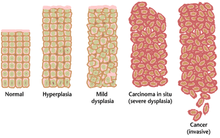Precancerous Condition

A precancerous condition is a condition or lesion involving abnormal cells which are associated with an increased risk of developing into cancer. Clinically, precancerous conditions encompass a variety of conditions or lesions with an increased risk of developing into cancer. Some of the most common precancerous conditions include certain colon polyps, which can progress into colon cancer, monoclonal gammopathy of undetermined significance, which can progress into multiple myeloma or myelodysplastic syndrome. and cervical dysplasia, which can progress into cervical cancer. Pathologically, precancerous lesions can range from benign neoplasias, which are tumors which do not invade neighboring normal tissues or spread to distant organs, to dysplasia, which involves collections of abnormal cells which in some cases have an increased risk of progressing to anaplasia and invasive cancer. Sometimes the term "precancer" is also used for carcinoma in situ, which is a noninvasive cancer that has not progressed to an aggressive, invasive stage. As with other precancerous conditions, not all carcinoma in situ will progress to invasive disease.
Classification
The term precancerous or premalignant condition may refer to certain conditions, such as monoclonal gammopathy of unknown significance, or to certain lesions, such as colorectal adenoma (colon polyps), which have the potential to progress into cancer (see: Malignant transformation). Premalignant lesions are morphologically atypical tissue which appear abnormal when viewed under the microscope, and which are more likely to progress to cancer than normal tissue. Precancerous conditions and lesions affect a variety of organ systems, including the skin, oral cavity, stomach, colon, and hematological system. Some authorities also refer to hereditary genetic conditions which predispose to developing cancer, such as hereditary nonpolyposis colorectal cancer, as a precancerous condition, as individuals with these conditions have a much higher risk of developing cancer in certain organs.
Signs and symptoms
The signs and symptoms of precancerous conditions differ based on the organ affected. In many cases, individuals with precancerous conditions do not experience any symptoms. Precancerous conditions of the skin or oral cavity often appear as visible lesions without associated pain or discomfort, while precancerous conditions of the hematological system are typically asymptomatic, or in the case of monoclonal gammopathy of unknown significance, may rarely cause numbness and tingling in the hands and feet or difficulty with balance (see: peripheral neuropathy).
Causes
In many cases, risk factors for precancerous conditions and lesions are the same risk factors that predispose individuals to a specific cancer. For example, individuals with cervical or anal infection with oncogenic, or cancer causing, strains of human papilloma virus (HPV) are at elevated risk for cervical and anal cancers, respectively, as well as for cervical and anal dysplasia. Similarly, sun exposure is an important risk factor for both actinic keratosis as well as skin cancer. However, in many cases, precancerous conditions or lesions can be sporadic and idiopathic in nature, meaning that they are not associated with a hereditary genetic predisposition to the particular cancer, nor with a direct causative agent or other identifiable cause.
Pathophysiology

The pathophysiology of precancerous lesions is thought to be similar to that of cancer, and varies depending on the disease site and type of lesion. It is thought that cancer is preceded by a clinically silent premalignant phase during which oncogenic genetic and epigenetic alterations accumulate. The duration of this premalignant phase can vary from cancer to cancer and from individual to individual.
Examples
Skin
- actinic keratosis
- Bowen's disease (intraepidermal carcinoma/squamous carcinoma in situ)
- dyskeratosis congenita
Breast
- ductal carcinoma in situ
- Sclerosing adenosis
- Small duct papilloma
Head and neck/oral
- oral submucous fibrosis
- erythroplakia
- lichen planus (oral)
- leukoplakia
- proliferative verrucous leukoplakia
- stomatitis nicotina
Gastrointestinal
- Barrett's esophagus
- atrophic gastritis
- colon polyp
- Plummer-Vinson syndrome (sideropenic dysphagia)
- hereditary nonpolyposis colorectal cancer
- Ulcerative colitis
- Crohn's disease
Gynecological
- cervical dysplasia (cervical intraepithelial neoplasm, CIN)
- vaginal intraepithelial neoplasm (VAIN)
- anal dysplasia (also see: anal cancer)
- lichen sclerosus
- Bowen's disease (penile or vulvar)
- erythroplasia of Queyrat
Urological
- bladder carcinoma in situ
Hematological
- monoclonal gammopathy of unknown significance